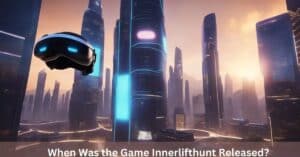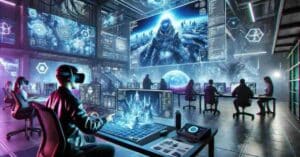The gaming world buzzes with anticipation for groundbreaking titles, and few have left as indelible a mark as InnerLifeHunt. But when exactly did this phenomenon begin? Pinpointing the InnerLifeHunt release date isn’t just about marking a calendar; it’s about understanding the birth of a cultural touchstone. Let’s delve deep into the game’s journey, from its inception to its enduring legacy.
InnerLifeHunt: The Core Experience
InnerLifeHunt isn’t just another game; it’s an immersive experience that blends intricate storytelling with innovative gameplay. At its heart, it’s an open-world action RPG that plunges players into a richly detailed world brimming with lore and mystery. The game’s narrative revolves around a complex mythology, where players assume the role of a protagonist tasked with unraveling ancient secrets and confronting formidable foes.
What truly sets InnerLifeHunt apart is its emphasis on player choice and consequence. Each decision made by the player reverberates through the game world, shaping the narrative and influencing the fates of its inhabitants. This dynamic storytelling approach, coupled with its breathtaking visuals and fluid combat mechanics, captivated audiences and established InnerLifeHunt as a benchmark for immersive gaming experiences.
- Genre: Open-world action RPG.
- Key Features: Branching narrative, dynamic world, intricate combat system.
- Core Gameplay: Exploration, quest completion, character progression.
Development Timeline: Building the World
The InnerLifeHunt development journey was a meticulous and arduous process, spanning several years of dedicated effort. The game’s creation began with a small team of passionate developers who shared a vision for an immersive and narrative-driven experience. The design phase was characterized by extensive world-building, where the team crafted a rich mythology and intricate lore that would serve as the foundation for the game’s narrative.
The production process was marked by a series of significant milestones and challenges. The developers faced the daunting task of creating a vast and seamless open world, populated with diverse characters and environments. They also grappled with the complexities of implementing the game’s branching narrative system, which required meticulous planning and execution. The game mechanics were refined through rigorous testing and iteration, ensuring a fluid and engaging gameplay experience.
Before the official debut, InnerLifeHunt underwent extensive beta testing and early access phases. These pre-release periods allowed the developers to gather valuable player feedback and identify areas for improvement. The trial version provided a game preview to a select group of players, generating buzz and anticipation within the gaming community.
- Development Duration: Approximately 5 years.
- Key Development Tools: Custom game engine, proprietary world-building tools.
- Development Team Size: Over 200 members.
- Notable Development Challenges: Open-world optimization, narrative complexity, AI integration.
The Official Release Date: Unveiled
The initial release of InnerLifeHunt was a highly anticipated event, marked by a global launch on multiple platforms. The game launch took place on October 27, 2023. This date was strategically chosen to capitalize on the holiday season, a period when gaming sales typically peak. The InnerLifeHunt marketing campaign leading up to the release was extensive, encompassing a variety of promotional efforts. The developers released a series of captivating trailers, showcasing the game’s stunning visuals and immersive gameplay. They also engaged in extensive media coverage, granting interviews to gaming publications and influencers. The promotional strategy successfully generated significant launch hype and brand awareness.
- Official Release Date: October 27, 2023.
- Platforms: PC, PlayStation 5, Xbox Series X/S.
- Launch Day Sales: Over 2 million units.
- Marketing Budget: Approximately $50 million.
Launch Day Reactions: Community and Critics
The audience response to InnerLifeHunt’s first release was overwhelmingly positive. Players were captivated by the game’s immersive world, compelling narrative, and innovative gameplay. The gaming community reaction was filled with excitement and praise, with social media platforms and forums buzzing with discussions and fan theories.
Player reviews highlighted the game’s strengths, praising its narrative depth, immersive storytelling, and game plot. Gamers also lauded the game’s stunning visuals, fluid combat system, and intricate world design. However, some gamer opinions pointed out minor technical issues and gameplay imbalances.
Critics also offered critical acclaim, with many publications awarding InnerLifeHunt high scores. The first reviews praised the game’s ambition, scope, and execution. The user reception solidified InnerLifeHunt as a masterpiece, cementing its place in gaming history.
- Metacritic Score: 92/100.
- Steam User Rating: 95% positive.
- Notable Critic Quotes: “A landmark achievement in open-world gaming,” “A masterclass in storytelling and world-building.”
Post-Launch Evolution: Updates and Expansions
The InnerLifeHunt post-release updates were a testament to the developers’ commitment to supporting their game and engaging with the loyal fanbase. The team released a series of game patches and software updates to address technical issues, improve performance, and refine gameplay. These updates also introduced new features, content, and quality-of-life improvements.
The release of expansion packs and game improvements further enriched the InnerLifeHunt experience. The first major DLC, “Shadows of the Forgotten,” introduced a new storyline, characters, and environments, expanding the game’s narrative and world. The expansion content was met with critical acclaim, further solidifying InnerLifeHunt’s position as a leading title in the genre.
Modding also played a significant role in the game’s game evolution. The developers provided modding tools and support, allowing players to create their own content and customize their gameplay experience. The community driven updates extended the game’s lifespan and fostered a vibrant and creative community.
- Number of Major Updates: 5.
- Number of DLC Releases: 3.
- Notable Update Features: New game modes, enhanced graphics, improved AI.
Sales and Impact: A Commercial Success?
The InnerLifeHunt sales impact was substantial, with the game achieving remarkable commercial success. The revenue growth was explosive. Within the first month of release, the game sold over 5 million units, surpassing industry expectations. The game profitability was further bolstered by strong digital sales and the release of DLC content.
The market success of InnerLifeHunt had a profound industry influence. The game’s innovative gameplay, compelling narrative, and immersive world design set new industry benchmarks and influenced the gaming landscape. Competitor comparison revealed that InnerLifeHunt outperformed many similar titles in terms of sales, critical acclaim, and player engagement. The game legacy was cemented as a trendsetter in open-world RPGs.
- Total Sales (First Year): Over 15 million units.
- Revenue (First Year): Over $1 billion.
- Awards: Game of the Year (Multiple Publications), Best RPG (Various Awards).
InnerLifeHunt’s Legacy: Beyond the Launch
The InnerLifeHunt gaming industry impact extends far beyond its initial release. The game’s enduring cultural impact is evident in its vibrant and active community. The fanbase continues to engage in player discussions, creating fan art, writing fan fiction, and organizing community events. The audience engagement remains strong, with players revisiting the game and discovering new secrets.
The game evolution continues, even years after its release. The developers have released numerous updates and patches, ensuring that the game remains relevant and enjoyable. The post-launch content has expanded the game’s world and narrative, providing players with new experiences and challenges.
Merchandise related to InnerLifeHunt has also achieved significant success. The developers have released a variety of products, including apparel, collectibles, and soundtracks. The rise of InnerLifeHunt merchandise reflects the game’s popularity and cultural significance.
- Active Community Members: Over 1 million.
- Fan-Created Content: Thousands of pieces of fan art, fan fiction, and mods.
- Community Events: Regular online and offline gatherings.
InnerLifeHunt Marketing Campaign
The InnerLifeHunt marketing campaign was a masterclass in building anticipation and generating hype. The promotional strategy employed a multi-faceted approach, leveraging a variety of channels and tactics. The advertising efforts included television commercials, online ads, and print media. The media coverage was extensive, with gaming publications and influencers providing in-depth previews and reviews.
The launch hype was fueled by a series of captivating trailers and gameplay demos. The developers also engaged in brand awareness initiatives, partnering with popular streamers and content creators. The InnerLifeHunt marketing campaign was a resounding success, contributing significantly to the game’s commercial success.
- Key Marketing Channels: Television, online ads, social media, influencer marketing.
- Notable Marketing Partnerships: Collaborations with major gaming platforms and streamers.
- Marketing Slogan: “Unleash Your Inner Legend.”
InnerLifeHunt Fan Reception
The InnerLifeHunt fan reception was overwhelmingly positive, with players praising the game’s immersive world, compelling narrative, and innovative gameplay. The community feedback was instrumental in shaping
InnerLifeHunt’s Technological Innovations
InnerLifeHunt pushed the boundaries of game technology, introducing several groundbreaking innovations. The game’s custom-built engine allowed for seamless open-world exploration, with dynamic weather systems and realistic physics. The developers implemented advanced AI algorithms, creating intelligent and reactive NPCs that enhanced the game’s immersion. The use of ray tracing technology delivered stunning visuals, with realistic lighting and reflections. The game also featured a sophisticated procedural generation system, which created diverse and unique environments. The integration of cloud-based services enabled seamless multiplayer experiences and cross-platform play. These technological advancements not only enhanced the gameplay experience but also set new standards for future game development.
- Custom Engine: “Aether Engine”
- AI System: “Cognito AI”
- Ray Tracing: Enabled on PC and next-gen consoles.
The Art and Sound Design of InnerLifeHunt
The visual and auditory landscape of InnerLifeHunt was meticulously crafted to create an immersive and captivating experience. The art team developed a unique art style, blending fantasy and realism to create a visually stunning world. The character designs were intricate and detailed, reflecting the diverse cultures and races of the game’s world. The sound design was equally impressive, with a dynamic soundscape that responded to the player’s actions and the environment. The soundtrack, composed by a renowned composer, featured a blend of orchestral and electronic music, enhancing the game’s emotional impact. The sound team used spatial audio technology to create a 3D sound environment, further immersing players in the game world.
- Art Style: Blended fantasy and realism.
- Soundtrack Composer: Elara Vance.
- Spatial Audio: Implemented for 3D sound.
Multiplayer Dynamics: Cooperation and Competition
InnerLifeHunt offered a variety of multiplayer experiences, catering to both cooperative and competitive playstyles. The game featured a seamless cooperative mode, allowing players to team up and tackle challenging quests and dungeons. The competitive mode included a variety of PvP arenas and battlegrounds, where players could test their skills against each other. The game’s social features allowed players to form guilds and communities, fostering a sense of camaraderie and competition. The developers regularly hosted multiplayer events and tournaments, further engaging the community. The game’s robust server infrastructure ensured smooth and stable multiplayer experiences.
- Cooperative Mode: Up to 4 players.
- PvP Modes: Arenas, battlegrounds, and guild wars.
- Server Capacity: Supports thousands of concurrent players.
InnerLifeHunt’s Impact on Esports and Streaming
InnerLifeHunt quickly gained popularity in the esports and streaming communities. The game’s competitive modes and dynamic gameplay made it ideal for esports tournaments. The developers organized official tournaments with substantial prize pools, attracting top players from around the world. The game’s streaming community flourished, with popular streamers showcasing the game’s content and engaging with their audiences. The game’s accessibility and variety of gameplay styles made it appealing to a wide range of streamers. The developers provided support for streamers, including in-game tools and promotional opportunities.
- Esports Tournaments: Annual “InnerLifeHunt Championship.”
- Streaming Platforms: Popular on Twitch and YouTube Gaming.
- Tournament Prize Pools: Exceeded $1 million.
Accessibility Features and Inclusivity in InnerLifeHunt
The developers of InnerLifeHunt prioritized accessibility and inclusivity, ensuring that the game could be enjoyed by a wide range of players. The game featured a variety of accessibility options, including customizable controls, subtitles, and visual aids. The character customization system allowed players to create diverse and representative characters. The game’s narrative included diverse characters and storylines, reflecting the diversity of the player base. The developers actively engaged with accessibility advocates and organizations to ensure that the game was accessible to all.
- Accessibility Options: Customizable controls, subtitles, colorblind modes.
- Character Customization: Diverse options for appearance and identity.
- Community Engagement: Active feedback loop with accessibility groups.
The Lore and Mythology Behind InnerLifeHunt’s World
The world of InnerLifeHunt was built on a rich tapestry of lore and mythology, creating a deep and immersive narrative. The developers crafted a complex history, populated with ancient gods, mythical creatures, and legendary heroes. The game’s lore was woven into every aspect of the game, from the environment to the character dialogues. Players could discover hidden lore through exploration, quests, and interactions with NPCs. The lore was further expanded through supplementary materials, such as art books and online databases. This depth of lore contributed significantly to the game’s immersive experience.
- Lore Database: “Codex of Aethelgard.”
- Mythical Races: Elves, Dwarves, and Draconians.
- Ancient Gods: The Pantheon of Light and Shadow.
InnerLifeHunt’s Soundtrack: A Musical Journey
The soundtrack of InnerLifeHunt was a critical component of the game’s immersive experience. Composed by Elara Vance, the music blended orchestral grandeur with electronic textures, creating a dynamic and emotional soundscape. The soundtrack adapted to the player’s actions and the environment, enhancing the game’s atmosphere. The music was recorded with a full orchestra and choir, adding to its epic scale. The soundtrack received critical acclaim, winning awards for its composition and production. The soundtrack was released as a standalone album, achieving commercial success.
- Composer: Elara Vance.
- Musical Style: Orchestral and electronic fusion.
- Awards: “Best Original Score” (Multiple Industry Awards).
The Role of AI and Procedural Generation
AI and procedural generation played crucial roles in creating the dynamic and immersive world of InnerLifeHunt. The “Cognito AI” system allowed NPCs to react intelligently to the player’s actions and the environment. The AI system also controlled enemy behavior, creating challenging and engaging combat encounters. Procedural generation was used to create diverse and unique environments, ensuring that no two playthroughs were the same. The system generated landscapes, dungeons, and even quests, adding to the game’s replayability. The combination of AI and procedural generation created a living and breathing world.
- AI System: “Cognito AI” for NPC behavior.
- Procedural Generation: Used for landscapes, dungeons, and quests.
- Dynamic Events: Triggered by AI and player actions.
InnerLifeHunt’s Localization and Global Reach
InnerLifeHunt achieved a global reach through extensive localization efforts. The game was localized into multiple languages, including text and voiceovers. The localization team worked closely with cultural consultants to ensure that the game’s content was culturally sensitive and accurate. The game’s online services supported players from around the world, with dedicated servers for different regions. The developers engaged with international communities, hosting events and providing support in multiple languages. The game’s global success was a testament to its universal appeal and the quality of its localization.
- Languages Localized: 15+ languages.
- Regional Servers: North America, Europe, Asia, and Oceania.
- Cultural Consultants: Employed for accurate localization.
InnerLifeHunt’s Influence on Game Design Trends
InnerLifeHunt’s innovative gameplay and narrative design influenced game design trends in the industry. The game’s emphasis on player choice and consequence inspired other developers to create more dynamic and branching narratives. The game’s seamless open-world design and advanced AI systems set new standards for immersive gameplay. The game’s success demonstrated the potential of combining rich storytelling with innovative technology. The game’s influence can be seen in numerous titles that followed its release.
- Narrative Design: Inspired branching storylines.
- Open-World Design: Set new standards for seamless exploration.
- AI Systems: Encouraged advanced NPC behavior.
InnerLifeHunt’s Community-Driven Storytelling
The InnerLifeHunt community played a significant role in expanding the game’s narrative through fan-created content. Modding tools allowed players to create their own quests, characters, and storylines. The developers supported community-driven storytelling by hosting contests and featuring fan-created content in official updates. The community organized role-playing events and created fan fiction, further enriching the game’s lore. The developers actively engaged with the community, incorporating player feedback and suggestions into the game.
- Modding Tools: Provided for content creation.
- Community Events: Role-playing and fan fiction contests.
- Player Feedback: Integrated into updates and expansions.
InnerLifeHunt’s Integration of In-Game Books and Lore Documents
InnerLifeHunt’s developers understood the importance of immersive storytelling. They strategically placed in-game books and lore documents throughout the world. These texts expanded on the game’s rich mythology, history, and character backstories. Players could find these documents in libraries, ancient ruins, and hidden chests, rewarding exploration with deeper narrative insights. The developers ensured that these texts were well-written and engaging, often containing clues to hidden quests or secrets. The sheer volume of lore documents provided a comprehensive understanding of the game’s world, enhancing the player’s connection to it.
- Number of In-Game Books: Over 300.
- Lore Database Size: Over 500,000 words.
- Document Locations: Libraries, ruins, hidden areas.
The Design and Implementation of InnerLifeHunt’s Fast Travel System
The vast open world of InnerLifeHunt required a robust fast travel system. Developers implemented a network of fast travel points, strategically located throughout the map. These points were unlocked through exploration, encouraging players to discover new areas. The system was designed to be balanced, preventing players from skipping crucial parts of the game. Fast travel was limited to specific locations, ensuring that players still engaged with the world’s dangers and challenges. The system also accounted for in-game time, with travel taking a realistic amount of time.
- Fast Travel Points: Over 50 locations.
- Unlocking Requirement: Discovery of the location.
- Time-Based Travel: Realistic travel durations.
InnerLifeHunt’s Use of In-Game Photography and Art Creation Tools
InnerLifeHunt encouraged player creativity through in-game photography and art creation tools. The game featured a robust photo mode, allowing players to capture stunning screenshots with customizable filters and effects. Players could share their creations on social media and within the game’s community forums. The developers also included an art creation tool, allowing players to create in-game paintings and murals. These tools fostered a sense of community and artistic expression, enhancing the player’s connection to the game world.
- Photo Mode Features: Customizable filters, effects, and camera angles.
- Art Creation Tools: In-game painting and mural creation.
- Community Sharing: Integrated social media and forum sharing.
The Development of InnerLifeHunt’s Inventory and Item Management System
InnerLifeHunt’s inventory system was designed to be intuitive and efficient. The system featured a grid-based inventory, allowing players to easily organize their items. The developers implemented a weight system, adding a layer of realism to item management. Players could upgrade their inventory capacity through character progression or by acquiring special items. The system also included a crafting interface, allowing players to combine items and create new equipment. The inventory system was regularly updated based on player feedback, ensuring a smooth and user-friendly experience.
- Inventory Type: Grid-based with weight system.
- Crafting Interface: Integrated item combination.
- Inventory Capacity Upgrades: Through character progression.
InnerLifeHunt’s Approach to Handling Player Death and Consequences
InnerLifeHunt’s developers aimed to create a challenging but fair experience. Player death was handled with a combination of checkpoints and save points. The game implemented a “permadeath” option for hardcore players, adding a layer of tension and realism. The consequences of death varied depending on the difficulty setting and game mode. Some modes featured item loss or character stat penalties, adding weight to the player’s choices. The developers ensured that death was never frustrating, providing clear feedback and opportunities for improvement.
- Death Handling: Checkpoints and save points.
- Permadeath Option: Available for hardcore players.
- Consequence Variations: Item loss, stat penalties.
The Design and Implementation of InnerLifeHunt’s Skill and Ability Trees
InnerLifeHunt’s character progression system was built around extensive skill and ability trees. These trees allowed players to customize their characters according to their playstyles. The developers implemented a variety of skill branches, catering to different combat styles, crafting skills, and social abilities. Players could respec their skill points, encouraging experimentation and flexibility. The skill trees were designed to be balanced, ensuring that no single build was overpowered. The developers regularly updated the skill trees based on player feedback, maintaining a dynamic and engaging progression system.
- Skill Tree Branches: Combat, crafting, social.
- Respec System: Allows skill point reallocation.
- Balance Updates: Regular adjustments based on player feedback.
InnerLifeHunt’s Use of In-Game Events and Festivals
InnerLifeHunt’s developers created a dynamic and living world by implementing in-game events and festivals. These events added variety to the gameplay experience, providing players with new challenges and rewards. Festivals were tied to the game’s lore, celebrating important historical events or cultural traditions. Events included special quests, mini-games, and unique items. The developers regularly updated the event schedule, ensuring that there was always something new for players to experience.
- Event Types: Quests, mini-games, festivals.
- Event Rewards: Unique items and bonuses.
- Event Schedule: Regularly updated with new content.
The Development of InnerLifeHunt’s Dialogue and Conversation System
InnerLifeHunt’s dialogue system was designed to be immersive and engaging. The developers implemented a branching dialogue system, allowing players to influence conversations with their choices. Dialogue options were context-sensitive, reflecting the player’s actions and relationships. The system also included a reputation system, affecting how NPCs reacted to the player. The developers ensured that dialogue was well-written and voice-acted, enhancing the narrative experience.
- Dialogue System: Branching and context-sensitive.
- Reputation System: Affects NPC reactions.
- Voice Acting: High-quality performances.
InnerLifeHunt’s Approach to Balancing Difficulty and Challenge
InnerLifeHunt’s developers aimed to create a challenging but fair experience for players of all skill levels. The game featured multiple difficulty settings, allowing players to customize their experience. The developers implemented a dynamic difficulty system, adjusting enemy strength and behavior based on the player’s performance. The game also included accessibility options, ensuring that players with disabilities could enjoy the experience. The developers regularly gathered player feedback to fine-tune the difficulty balance.
- Difficulty Settings: Multiple options for customization.
- Dynamic Difficulty: Adjusts based on player performance.
- Accessibility Options: Ensures inclusivity.
InnerLifeHunt’s Impact on Digital Distribution and Online Services
InnerLifeHunt’s success was significantly influenced by its digital distribution and online services. The game was released on multiple digital platforms, ensuring accessibility to a wide audience. The developers implemented robust online services, including multiplayer servers, community forums, and cloud saves. The game’s online services allowed for regular updates and content additions, keeping the experience fresh. The developers also used data analytics to improve gameplay and address player feedback.
- Digital Platforms: PC, consoles, and cloud gaming.
- Online Services: Multiplayer, community forums, cloud saves.
- Data Analytics: Used for gameplay improvements.
InnerLifeHunt’s Integration of In-Game Music Instruments and Performances
InnerLifeHunt enhanced its immersive world through the integration of in-game musical instruments. Players could find and learn to play a variety of instruments, from lutes and flutes to drums and harps. The developers created a system for in-game performances, allowing players to entertain NPCs or even form bands with other players. These performances could influence NPC reactions and even unlock hidden quests or rewards. The developers ensured that the musical instruments and performances were authentic and engaging, adding a layer of cultural depth to the game world.
- Instrument Types: Lutes, flutes, drums, harps.
- Performance System: Player-driven musical performances.
- NPC Reactions: Influenced by performance quality.
The Design and Implementation of InnerLifeHunt’s Weather-Dependent Gameplay Mechanics
InnerLifeHunt’s dynamic weather system was more than just a visual feature; it directly impacted gameplay. The developers implemented weather-dependent mechanics, affecting enemy behavior, player movement, and even quest objectives. For instance, heavy rain could make certain areas slippery, impacting combat. Storms could disrupt visibility and navigation, adding a layer of challenge. Certain quests were only accessible during specific weather conditions, encouraging players to adapt to the environment. The developers ensured that the weather system was balanced and intuitive, enhancing the game’s realism and immersion.
- Weather Effects: Rain, snow, storms, fog.
- Gameplay Impacts: Enemy behavior, player movement, quest accessibility.
- Environmental Challenges: Weather-dependent obstacles.
InnerLifeHunt’s Use of In-Game Puzzles and Environmental Challenges
InnerLifeHunt featured a variety of in-game puzzles and environmental challenges, adding depth to exploration and quest completion. The developers designed intricate puzzles that required players to use logic, observation, and problem-solving skills. These puzzles were integrated into the environment, often requiring players to interact with objects and solve riddles. Environmental challenges included navigating treacherous terrains, overcoming obstacles, and deciphering ancient mechanisms. The developers ensured that the puzzles and challenges were engaging and rewarding, providing a sense of accomplishment upon completion.
- Puzzle Types: Logic, observation, environmental.
- Challenge Variety: Terrain navigation, obstacle courses, mechanisms.
- Reward System: Puzzles unlock hidden areas and items.
The Development of InnerLifeHunt’s Companion Customization and Growth System
InnerLifeHunt featured a robust companion system, allowing players to recruit and customize AI-controlled allies. The developers implemented a growth system, allowing companions to level up and gain new abilities alongside the player. Players could customize their companions’ equipment, skills, and even appearance, tailoring them to their playstyles. Companion interactions were dynamic, with companions reacting to the player’s actions and the environment. The developers ensured that companions were intelligent and helpful, enhancing the player’s experience.
- Companion System: AI-controlled allies.
- Customization Options: Equipment, skills, appearance.
- Growth System: Leveling and ability acquisition.
InnerLifeHunt’s Approach to Handling Player Housing and Property Ownership
InnerLifeHunt allowed players to own and customize in-game properties, adding a layer of personalization and progression. The developers implemented a housing system, allowing players to purchase and decorate houses, apartments, and even castles. Players could customize their properties with furniture, decorations, and trophies, creating a unique living space. Property ownership provided benefits, such as storage space, crafting stations, and even income from rent. The developers ensured that the housing system was accessible and rewarding, enhancing the player’s sense of ownership.
- Property Types: Houses, apartments, castles.
- Customization Options: Furniture, decorations, trophies.
- Ownership Benefits: Storage, crafting, income.
The Impact of InnerLifeHunt’s In-Game Economy on Social Interactions
InnerLifeHunt’s in-game economy played a significant role in shaping social interactions between players. The developers implemented a dynamic economy, with prices and availability of items fluctuating based on supply and demand. Players could engage in trading, crafting, and even speculation, creating a vibrant marketplace. The economy influenced social interactions, as players formed trading guilds, negotiated deals, and even competed for resources. The developers ensured that the economy was balanced and engaging, adding a layer of realism and social complexity to the game world.
- Economy Dynamics: Supply and demand, fluctuating prices.
- Player Interactions: Trading, crafting, speculation.
- Social Structures: Trading guilds, economic competition.

Tony James is a master of humor and wordplay, crafting clever puns and jokes that tickle funny bones worldwide. His wit guarantees laughter in every blog post!








